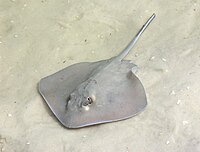
Photo from wikipedia
Abstract Reproductive management of cownose rays (Rhinoptera bonasus) under professional care plays an important role in conservation of the species, but hormone and ultrasonographic analyses of their 12-mo reproductive cycle… Click to show full abstract
Abstract Reproductive management of cownose rays (Rhinoptera bonasus) under professional care plays an important role in conservation of the species, but hormone and ultrasonographic analyses of their 12-mo reproductive cycle have not been documented previously. Plasma reproductive hormone concentrations (17B-estradiol, progesterone, testosterone, and androstenedione) were measured monthly via radioimmunoassay for 1 yr in an aquarium-managed population of adult females (n = 15) and males (n = 5). Ultrasounds of the uterus were performed each month at the time of sample collection to identify gestation stage (0–5) based on a previously developed in-house staging system. Stages were correlated to hormone concentrations to track progression through pregnancy. Thirteen females were reproductively active, and each produced one pup in March–June, similar to timing for free-ranging populations. Female estradiol increased steadily throughout gestation from stages 0 to 5, while progesterone, testosterone, and androstenedione were increased only in early gestation (stages 1 and 2). Unlike month of year, gestation stage strongly predicted hormone concentration, but specific values to predict parturition date were not identified. Male testosterone and progesterone were higher in March–June (mating season) than July–January, while estradiol and androstenedione did not exhibit a seasonal pattern. Aquarium-managed cownose rays have similar reproductive patterns to what is reported in wild populations. Ultrasonographic monitoring with serial hormone analysis and accurate mating records will provide the most useful information for managing a reproductive population of cownose rays in an aquarium setting.
Journal Title: Journal of Zoo and Wildlife Medicine
Year Published: 2018
Link to full text (if available)
Share on Social Media: Sign Up to like & get
recommendations!